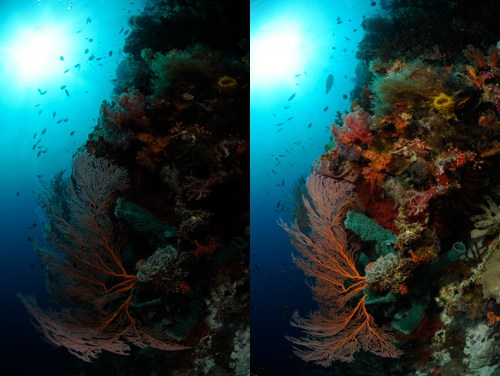
Robohub.org
Underwater robot photography and videography

I had somebody ask me questions this week about underwater photography and videography with robots (well, now it is a few weeks ago…). I am not an expert at underwater robotics, however as a SCUBA diver I have some experience that can be applicable towards robotics.
Underwater Considerations
There are some challenges that exist with underwater photography and videography, that are less challenging above the water. Some of them include:
1) Water reflects some of the light that hits the surface, and absorbs the light that travels through it. This causes certain colors to not be visible at certain depths. If you need to see those colors you often need to bring strong lights to restore the visibility of those wavelengths that were absorbed. Red’s tend to disappear first, blues are the primary color seen as camera depth increases. A trick that people often try is to use filters on the camera lens to make certain colors more visible.
If you are using lights then you can get the true color of the target. Sometimes if you are taking images you will see one color with your eye, and then when the strobe flashes a “different color” gets captured. In general you want to get close to the target to minimize the light absorbed by the water.

Visible colors at given depths underwater. [Image Source]
For shallow water work you can often adjust the white balance to sort of compensate for the missing colors. White balance goes a long ways for video and compressed images (such as .jpg). Onboard white balance adjustments are not as important for photographs stored as with a raw image format, since you can deal with it in post processing. Having a white or grey card in the camera field of view (possibly permanently mounted on the robot) is useful for setting the white balance and can make a big difference. The white balance should be readjusted every so often as depth changes, particularly if you are using natural lighting (ie the sun).
Cold temperate water tends to look green (such as a freshwater quarry) (I think from plankton, algae, etc..). Tropical waters (such as in the Caribbean) tend to look blue near the shore and darker blue as you get further away from land (I think based on how light reflects off from the bottom of the water)… Using artificial light sources (such as strobes) can minimize those colors in your imagery.
Auto focus generally works fine underwater. However if you are in the dark you might need to keep a focus light turned on to help the autofocus work, and then a separate strobe flash for taking the image. Some systems turn the focus light off when the images are being taken. This is generally not needed for video as the lights are continuously turned on.
2) Objects underwater appear closer and larger than they really are. A rule of thumb is that the objects will appear 25% larger and/or closer.
3) Suspended particles in the water (algae, dirt, etc..) scatters light which can make visibility poor. This can obscure details in the camera image or make things look blurry (like the camera is out of focus). A rule of thumb is your target should be less than 1/4 distance away from the camera as your total visibility.
The measure of the visibility is called turbidity. You can get turbidity sensors that might let you do something smart (I need to think about this more).
To minimize the backscatter from turbidity there is not a “one size fits all” solution. The key to minimizing backscatter is to control how light strikes the particles. For example if you are using two lights (angled at the left and right of the target), the edge of each cone of light should meet at the target. This way the water between the camera and the target is not illuminated. For wide-angle lenses you often want the light to be behind the camera (out of its plane) and to the sides at 45° angles to the target. With macro lenses you usually want the lights close to the lens.
“If you have a wide-angle lens you probably will use a domed port to protect the camera from water and get the full field of view of the camera.
The dome however can cause distortion in the corners. Here is an interesting article on flat vs dome ports.”
Another tip is to increase the exposure time (such as 1/50th of a second) to allow more natural light in, and use less strobe light to reduce the effect from backscatter.
4) Being underwater usually means you need to seal the camera from water, salts, (and maybe sharks). Make sure the enclosure and seals can withstand the pressure from the depth the robot will be at. Also remember to clean (and lubricate) the O rings in the housing.
“Pro Tip:Here are some common reasons for O ring seals leaking:
a. Old or damaged O rings. Remember O rings don’t last forever and need to be changed.
b. Using the wrong O ring
c. Hair, lint, or dirt getting on the O ring
d. Using no lubricant on the O ring
e. Using too much lubricant on the O rings. (Remember on most systems the lubricant is for small imperfections in the O ring and to help slide the O rings in and out of position.)”
5) On land it is often easy to hold a steady position. Underwater it is harder to hold the camera stable with minimal motion. If the camera is moving a faster shutter speed might be needed to avoid motion blur. This also means that less light is entering the camera, which is the downside of having the faster shutter speed.
When (not if) your camera floods
When your enclosure floods while underwater (or a water sensor alert is triggered):
a. Shut the camera power off as soon as you can.
b. Check if water is actually in the camera. Sometimes humidity can trigger moisture sensors. If it is humidity, you can add desiccant packets in the camera housing.
c. If there is water, try to take the camera apart as much as you reasonably can and let it dry. After drying you can try to turn the camera on and hope that it works. If it works then you are lucky, however remember there can be residual corrosion that causes the camera to fail in the future. Water damage can happen instantaneously or over time.
d. Verify that the enclosure/seals are good before sending the camera back in to the water. It is often good to do a leak test in a sink or pool before going into larger bodies of water.
e. The above items are a standard response to a flooded camera. You should read the owner’s manual of your camera and follow those instructions. (This should be obvious, I am not sure why I am writing this).
Do you have other advice for using cameras underwater and/or attached to a robot? Leave them in the comment section below.
I want to thank John Anderson for some advice for writing this post. Any mistakes that may be in the article are mine and not his.
The main image is from divephotoguide.com. They have a lot of information on underwater cameras, lens, lights and more.
This post appeared first on Robots For Roboticists.




